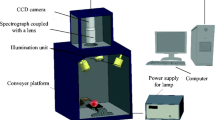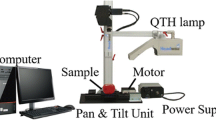Abstract
Hyperspectral scattering image technology is an effective method for nondestructive measurement of internal qualities of agricultural products. However, hyperspectral scattering images contain a large number of redundant data that affect the detection performance and efficiency. A new semi-supervised affinity propagation (AP) (NSAP) algorithm coupled with partial least square regression was proposed to select the feature wavelengths from the hyperspectral scattering profiles of “Golden Delicious” apples for predicting apple firmness and soluble solid content (SSC). Six hundred apples were analyzed in the experiment, 400 of which were used for the calibration model and the remaining 200 apples were used for the prediction model. Compared with full wavelengths, the number of effective wavelengths for apple firmness and SSC prediction selected by NSAP, respectively, decreased to 28 and 40 %. The root mean square error of prediction decreased from 6.6 to 6.1 N and from 0.66 to 0.63 %, respectively, whereas the correlation coefficient increased from 0.840 to 0.862 and from 0.876 to 0.890, respectively. Better prediction accuracy was achieved by the prediction model using selected wavelengths by NSAP than that by traditional AP, SAP, and genetic algorithm. The NSAP approach provided an effective means of wavelength selection using hyperspectral scattering image technique.








Similar content being viewed by others
References
Abbott JA (1999) Quality measurement of fruits and vegetables. Postharvest Biol Technol 15:207–225
Armstrong PR, Stone ML, Brusewitz GH (1997) Peach firmness determination using two different nondestructive vibrational sensing instruments. Trans ASAE 40:699–703
Dan T, Dai L (2009) Spectral wavelength selection based on PLS projection analysis. Spectrosc Spectr Anal 29:351–354
Frey BJ, Dueck D (2007) Clustering by passing messages between data points. Science 315:972–976
Huang S, Chen Q (2009) On clustering algorithm of high dimensional data based on similarity measurement. Comput Appl Softw 26:102–105
Huang M, Lu R (2010) Optimal wavelengths selection for hyperspectral scattering prediction of apple firmness and soluble solids content. Trans ASABE 53:1175–1182
Koumonsis K, Katsaras C (2006) A saw-tooth genetic algorithm combining the effects of variable and reinitialization to enhance performance. IEEE Trans Evol Comput 10:19–28
Kracik J (2011) Combining marginal probability distributions via minimization of weighted sum of Kullback–Leibler divergences. Int J Approx Reason 14:1–13
Lu R (2004) Multispectral imaging for predicting firmness and soluble solids content of apple fruit. Postharvest Biol Technol 31:147–157
Lu R (2007) Nondestructive measurement of firmness and soluble solids content for apple fruit using hyperspectral scattering images. Sens & Instrumen Food Qual Saf 1:19–27
Lu R, Ariana D (2002) A near-infrared sensing technique for measuring internal quality of apple fruit. Appl Eng Agric 18:585–590
Lu R, Guyer DE, Beaudry RM (2000) Determination of firmness and sugar content of apples using near-infrared diffuse reflectance. J Texture Stud 31:615–630
McGlone VA, Jordan RB, Martinsen PJ (2002) Vis/NIR estimation at harvest of pre- and post-storage quality indices for ‘Royal Gala’ apple. Postharvest Biol Technol 25:135–144
Mendoza F, Lu R, Ariana D, Cen H, Bailey BB (2011) Integrated spectral and image analysis of hyperspectral scattering data for prediction of apple fruit firmness and soluble solids content. Postharvest Biol Technol 62:149–160
Min M, Lee WS (2005) Determination of significant wavelengths and prediction of nitrogen content for citrus. Trans ASAE 48:455–461
Peng Y, Lu R (2006) An LCTF-based multispectral imaging system for estimation of apple fruit firmness. Part I. Acquisition and characterization of scattering images. Trans ASAE 49:259–267
Peng Y, Lu R (2008) Analysis of spatially resolved hyperspectral scattering images for assessing apple fruit firmness and soluble solids content. Postharvest Biol Technol 48:52–62
Qian Y, Yao F, Jia S (2009) Band selection for hyperspectral imagery using affinity propagation. IET Comput Vis 34:213–222
Qin J, Lu R (2007) Measurement of the absorption and scattering properties of turbid liquid foods using hyperspectral imaging. Appl Spectrosc 61:388–396
Qin J, Lu R (2008) Measurement of the optical properties of fruits and vegetables using spatially resolved hyperspectral diffuse reflectance imaging technique. Postharvest Biol Technol 49:355–365
Qin J, Lu R, Peng Y (2009) Prediction of apple internal quality using spectral absorption and scattering properties. Trans ASABE 52(2):499–507
Wang S, Huang M, Zhu Q (2012) Model fusion for prediction of apple firmness using hyperspectral scattering image. Comput Electron Agric 80:1–7
Zude M, Herold BJ, Roger M, Bellon-Maurel V, Landahl S (2006) Non-destructive tests on the prediction of apple fruit flesh firmness and soluble solids content on tree and in shelf life. J Food Eng 77:254–260
Acknowledgments
Authors gratefully acknowledge the guidance of Dr. Lu who works at Postharvest Engineering Laboratory of US Department of Agriculture for this experiment and financial support from the National Natural Science Foundation of China (grant no. 60805014), the Natural Science Foundation of Jiangsu Province (China, grant no. BK2011148), the Postdoctoral Science Foundation of China (grant no. 2011M500851), the Fundamental Research Funds for the Central Universities (grant no. JUSRP21132), and the 111 Project (B12018).
Author information
Authors and Affiliations
Corresponding author
Rights and permissions
About this article
Cite this article
Zhu, Q., Huang, M., Zhao, X. et al. Wavelength Selection of Hyperspectral Scattering Image Using New Semi-supervised Affinity Propagation for Prediction of Firmness and Soluble Solid Content in Apples. Food Anal. Methods 6, 334–342 (2013). https://doi.org/10.1007/s12161-012-9442-2
Received:
Accepted:
Published:
Issue Date:
DOI: https://doi.org/10.1007/s12161-012-9442-2




